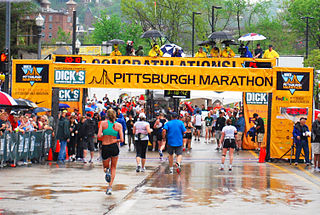
The London Marathon is an annual marathon held in London, England. It is the largest marathon in the world, with over 53,700 finishers in 2024, and 840,318 applicants for the 2025 event. Founded by athletes Chris Brasher and John Disley in 1981, it is typically held in April, although it moved to October for 2020, 2021, and 2022 due to the COVID-19 pandemic. The largely flat course is set around the River Thames, starting in Blackheath and finishing at The Mall. Hugh Brasher is the current race director and Nick Bitel its chief executive.

The marathon is a long-distance foot race with a distance of 42.195 km, usually run as a road race, but the distance can be covered on trail routes. The marathon can be completed by running or with a run/walk strategy. There are also wheelchair divisions. More than 800 marathons are held worldwide each year, with the vast majority of competitors being recreational athletes, as larger marathons can have tens of thousands of participants.

In Africa, the Big five game animals are the lion, leopard, rhinoceros, elephant, and African buffalo. The term was coined by big-game hunters to refer to the five most difficult animals in Africa to hunt on foot, but is now more widely used by game viewing tourists and safari tour operators. They are examples of charismatic megafauna, featuring prominently in popular culture, and are among the most famous of Africa's large animals.

The Boston Marathon is an annual marathon race hosted by several cities and towns in greater Boston in eastern Massachusetts, United States. It is traditionally held on Patriots' Day, the third Monday of April. Begun in 1897, the event was inspired by the success of the first marathon competition in the 1896 Summer Olympics. The Boston Marathon is the world's oldest annual marathon and ranks as one of the world's best-known road racing events. It is one of six World Marathon Majors. Its course runs from Hopkinton in southern Middlesex County to Copley Square in Boston.

An ultramarathon is a footrace longer than the traditional marathon distance of 42.195 kilometres. The sport of running ultramarathons is called ultra running or ultra distance running.

The Comrades Marathon is an ultramarathon of approximately 88 kilometres (55 mi) which is run annually in the KwaZulu-Natal province of South Africa between the cities of Durban and Pietermaritzburg. It is the world's largest and oldest ultramarathon race. The direction of the race alternates each year between the "up" run (87.6km) starting from Durban and the "down" run (87.7km) starting from Pietermaritzburg.

The Two Oceans Marathon is a 56 kilometres (35 mi) ultramarathon and 21 kilometres (13 mi) half-marathon held annually in Cape Town, South Africa on the Saturday(Ultra) and Sunday(Half) the weekend after Easter weekend.(previously was on Easter weekend)

Akagera National Park is a protected area in eastern Rwanda covering 1,122 km2 (433 sq mi) along the international border with Tanzania. It was founded in 1934 and includes savannah, montane and swamp habitats. The park is named for the Kagera River which flows along its eastern boundary feeding into Lake Ihema and several smaller lakes. The complex system of lakes and linking papyrus swamps makes up over a third of the park, which is the largest protected wetland in Eastern-Central Africa.

South Luangwa National Park is in eastern Zambia, the southernmost of three national parks in the valley of the Luangwa River. It is a world-renowned wildlife haven which is known to locals simply as "the South Park." Concentrations of game along the meandering Luangwa River and its lagoons are amongst the most intense in Africa. The river teems with hippo and crocodile and provides a lifeline for one of the greatest diversities of habitat and wildlife, supporting more than 60 species of mammals and over 400 species of birds. It marks the end of the Great Rift Valley.
The Great Wall Marathon is an annual marathon race, traditionally held on the third Saturday of May along and on the Huangyaguan or Huangya Pass, Tianjin section of the Great Wall of China, East of Beijing. Since it first started in 1999, the race has grown to several hundred participants. A locally organized event offering a full selection of runs including a full marathon (42.2k), half marathon (21.1k), 10k, and 5k distances. Aside from the main marathon, a half marathon, 10 km and 5 km runs were also held until 2012. 2013 marked the debut of an 8.5 km "fun run", replacing the 5 and 10 km distances. The course is much tougher than traditional marathons with participants challenged by 5,164 stone steps and many steep ascents and descents.

The men's marathon at the 1904 Summer Olympics in St. Louis, United States, took place on August 30 of that year, over a distance of 24 miles 1500 yards.

The Pittsburgh Marathon is an annual road marathon usually held on the first Sunday in May in Pittsburgh, Pennsylvania, in the United States, first held in 1985. The hilly course runs through the city center and crosses each of Pittsburgh's three main rivers. Generally, over 3,000 runners finish the marathon each year. The weekend's events also include a half marathon, marathon relay, and 5K.
The Harpeth Hills Flying Monkey Marathon is a 26.2-mile (42.2 km) road race in Percy Warner Park, the larger of the Warner Parks in Nashville, Tennessee. It was created to be among the top five most difficult road marathons in the United States, and was designed to be somewhat anti-establishment and grassroots in character. In particular, the Harpeth Hills Flying Monkey Marathon is consciously not part of any running series and is neither certified nor sanctioned by the USATF, but is the standard 42.195 kilometres (26.219 mi). A runner cannot use this race to qualify for the Boston Marathon. This marathon was initially dreamt up by a broad array of Middle Tennessee runners and was first described on an internet message board dedicated to Middle Tennessee runners. The original organizers included Trent Rosenbloom, The Nashville Striders, Peter Pressman, Diana Bibeau, and others.

Balule Nature Reserve is a protected area in Limpopo Province, South Africa which forms part of the Greater Kruger National Park as a member of the Associated Private Nature Reserves (APNR). As part of a wildlife conservation initiative, all fences separating APNR reserves – Balule, Timbavati, Klaserie, Umbabat, – and the Kruger National Park have been removed.

The Utah Valley Marathon (UVM) is an annual marathon foot-race in Northern Utah held on the first Saturday of June. The marathon course is USA Track & Field (USATF) certified and is a Boston Marathon qualifier.
The Lewa Safari Marathon is an annual fund raising event held at Lewa Downs, about 140 miles (230 km) north of Nairobi, Kenya. The 42.195-kilometre (26.219 mi) endurance race is sponsored by Safaricom in partnership with the Lewa Wildlife Conservancy and Tusk in order to raise funds for numerous community development and wildlife conservation efforts. Most well known for its unique setting, Runner's World Magazine named the Lewa Marathon as being, 'One of the top ten races to run in your life'.

African Cats is a 2011 nature documentary film about a pride of lions and a family of cheetahs trying to survive in the African savannah directed by Alastair Fothergill and Keith Scholey. The film was released theatrically by Disneynature on Earth Day, April 22, 2011. The film is narrated by Samuel L. Jackson. A portion of the proceeds for the film were donated to the African Wildlife Foundation and their effort to preserve Kenya's Amboseli Wildlife Corridor. The film's initiative with the African Wildlife Foundation is named "See African Cats, Save the Savanna", and as of May 2011, ticket sales translated into 50,000 acres of land saved in Kenya.

Mudumu is a National Park in Caprivi Region of north-eastern Namibia. Established in 1990, the park covers an area of 737 square kilometres (285 sq mi). The Kwando River forms the western border with Botswana. Various communal area conservancies and community forests surround Mudumu National Park.

The Dinokeng Game Reserve is a wildlife sanctuary in the province of Gauteng, South Africa and can be accessed via the N1 route. It is a 40-minute drive from Pretoria or 75 minutes from the O. R. Tambo Airport and Johannesburg. The reserve has the Big Five game animals, and is open for visitors to explore. It covers an area of approximately 21,000 hectares. The name, Dinokeng, is derived from the language of the Tswana and Bapedi people, and is translated as “a place of rivers”.

Athletics at the 2024 Summer Olympics in Paris were held between 1 and 11 August 2024, featuring a total of 48 medal events across three distinct sets: track and field, road running, and racewalking. Four venues were used: Pont d'Iéna for race walking, Hôtel de Ville and Les Invalides for the start and end points of the marathon races, and Stade de France for the track and field events.
















